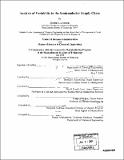| dc.contributor.advisor | Donald B. Rosenfield and David Simchi-Levi. | en_US |
| dc.contributor.author | Levesque, Joseph C. (Joseph Christopher), 1973- | en_US |
| dc.contributor.other | Leaders for Manufacturing Program. | en_US |
| dc.date.accessioned | 2006-11-08T16:34:13Z | |
| dc.date.available | 2006-11-08T16:34:13Z | |
| dc.date.copyright | 2004 | en_US |
| dc.date.issued | 2004 | en_US |
| dc.identifier.uri | http://hdl.handle.net/1721.1/34764 | |
| dc.description | Thesis (M.B.A.)--Massachusetts Institute of Technology, Sloan School of Management; and, (S.M.)--Massachusetts Institute of Technology, Dept. of Chemical Engineering; in conjunction with the Leaders for Manufacturing Program at MIT, 2004. | en_US |
| dc.description | Includes bibliographical references (p. 94-96). | en_US |
| dc.description.abstract | While the pace of technical innovation in the semiconductor industry continues to accelerate, business processes and supply chain techniques have not kept up. Microprocessor performance improvement continues to follow Moore's Law, but increased variability has complicated efforts to accurately forecast demand and set inventory targets. Products are becoming more complex, often containing assemblies of multiple parts. Lifecycles are becoming shorter; made possible by technology breakthroughs and efficient manufacturing ramp-ups. Demand and supply are ever more stochastic and non-stationary. Inventory is one of the few ways that a firm can buffer themselves from the inherent and increasing variability, while still meeting required service levels. We explore the sources of the variability in the semiconductor supply chain. On the supply side, we evaluate variability in throughput time, yield and other factors not explicitly considered in standard models. Here, we primarily focus on the natural stochasticity of the manufacturing process and disregard the variability arising from forecasting of these supply parameters. For demand, the natural stochastic process is not well understood, so we evaluate the forecast error and use it as a proxy for demand variability. We then apply these data to the base-stock model - constrained by its associated assumptions - to calculate inventory targets required to meet a certain level of service. Using a two-node base-stock model in conjunction with the actual variability data, we develop inventory estimates across the network and evaluate tradeoffs between different inventory strategies. We then determine what each variability parameter contributes to inventory. The combination of a simple yet representative | en_US |
| dc.description.abstract | (cont.) model of the semiconductor supply chain with actual data from the variability characterization provides the tools to make powerful recommendations to reduce variability and decrease inventories throughout the supply network. | en_US |
| dc.description.statementofresponsibility | by Joseph C. Levesque. | en_US |
| dc.format.extent | 113 p. | en_US |
| dc.format.extent | 5236744 bytes | |
| dc.format.extent | 5248312 bytes | |
| dc.format.mimetype | application/pdf | |
| dc.format.mimetype | application/pdf | |
| dc.language.iso | eng | en_US |
| dc.publisher | Massachusetts Institute of Technology | en_US |
| dc.rights | M.I.T. theses are protected by copyright. They may be viewed from this source for any purpose, but reproduction or distribution in any format is prohibited without written permission. See provided URL for inquiries about permission. | en_US |
| dc.rights.uri | http://dspace.mit.edu/handle/1721.1/7582 | |
| dc.subject | Sloan School of Management. | en_US |
| dc.subject | Chemical Engineering. | en_US |
| dc.subject | Leaders for Manufacturing Program. | en_US |
| dc.title | Analysis of variability in the semiconductor industry | en_US |
| dc.type | Thesis | en_US |
| dc.description.degree | S.M. | en_US |
| dc.description.degree | M.B.A. | en_US |
| dc.contributor.department | Leaders for Manufacturing Program at MIT | en_US |
| dc.contributor.department | Massachusetts Institute of Technology. Department of Chemical Engineering | |
| dc.contributor.department | Sloan School of Management | |
| dc.identifier.oclc | 56714526 | en_US |
